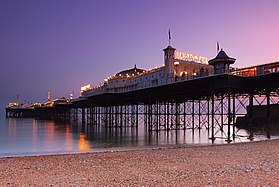Brighton, England
| Brighton | |
|---|---|

Brighton Pier at dusk
|
|
|
|
|
| Coordinates: 50°50′35″N 0°07′53″W / 50.842941°N 0.131312°WCoordinates: 50°50′35″N 0°07′53″W / 50.842941°N 0.131312°W | |
| Sovereign state | United Kingdom |
| Constituent country | England |
| Region | South East England |
| Ceremonial county | East Sussex |
| Unitary authority | Brighton and Hove |
| Admin HQ | Hove Town Hall |
| Town charter | 1313 |
| Incorporated | 1854 |
| Unitary authority | 1997 |
| City status | 2000 |
| Government | |
| • Type | Unitary authority |
| • Governing body | Brighton and Hove City Council |
| • Leader | Max Hyde (Lab) |
| • Mayor | Aaron Gibson (Con) |
| • MPs |
Simon Kirby (Con, Brighton Kemptown) Caroline Lucas (Green, Brighton Pavilion) |
| Area | |
| • Total | 31.97 sq mi (82.79 km2) |
| Population (mid-2015 est.) | |
| • Total | 285,300 (Ranked 42nd) |
| • Density | 8,920/sq mi (3,445/km2) |
| Demonym(s) | Brightonian |
| Time zone | GMT (UTC0) |
| • Summer (DST) | BST (UTC+1) |
| Postcode area | BN |
| Area code(s) | 01273 |
| ISO 3166-2 | GB-BNH |
| ONS code | 00ML (ONS) E06000043 (GSS) |
| OS grid reference | TQ315065 |
| NUTS 3 | UKJ21 |
| Website | brighton-hove.gov.uk |
Brighton ![]() i/ˈbraɪtən/ is a seaside resort on the south coast of England. It is part of the ceremonial county of East Sussex, within the historic county of Sussex.
i/ˈbraɪtən/ is a seaside resort on the south coast of England. It is part of the ceremonial county of East Sussex, within the historic county of Sussex.
Archaeological evidence of settlement in the area dates back to the Bronze Age, Roman and Anglo-Saxon periods. The ancient settlement of "Brighthelmstone" was documented in the Domesday Book (1086). The town's importance grew in the Middle Ages as the Old Town developed, but it languished in the early modern period, affected by foreign attacks, storms, a suffering economy and a declining population. Brighton began to attract more visitors following improved road transport to London and becoming a boarding point for boats travelling to France. The town also developed in popularity as a health resort for sea bathing as a purported cure for illnesses.
In the Georgian era, Brighton developed as a fashionable seaside resort, encouraged by the patronage of the Prince Regent, later King George IV, who spent much time in the town and constructed the Royal Pavilion in the Regency era. Brighton continued to grow as a major centre of tourism following the arrival of the railways in 1841, becoming a popular destination for day-trippers from London. Many of the major attractions were built in the Victorian era, including the Grand Hotel, the West Pier, and the Brighton Palace Pier. The town continued to grow into the 20th century, expanding to incorporate more areas into the town's boundaries before joining the town of Hove to form the unitary authority of Brighton and Hove in 1997, which was granted city status in 2000.
...
Wikipedia

